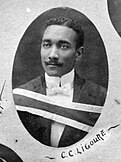Wikipedia:Main Page history/2023 March 16b
From today's featured article
The Bougainville counterattack (8–25 March 1944) was an unsuccessful Japanese offensive against the Allied base at Cape Torokina, on Bougainville Island (now part of Papua New Guinea), during the Pacific War of the Second World War. The goal of the offensive was to destroy the Allied beachhead, which accommodated three strategically important airfields. The Allies detected Japanese preparations and strengthened the base's defenses. The attack, hampered by inaccurate intelligence and poor planning, was repulsed mainly by United States Army forces (artillery pictured) after intense fighting. The Japanese commanders had underestimated the strength of the U.S. defenders, who greatly outnumbered them, and suffered severe casualties, while Allied losses were light. This attack was the last big Japanese offensive in the Solomon Islands campaign. In late 1944 Australian troops took over from the Americans and began a series of advances across the island that lasted until the end of the war in August 1945. (Full article...)
Did you know ...
- ... that Clement Ligoure (pictured) treated hundreds of blast victims at his home clinic following the Halifax Explosion in 1917?
- ... that New York City's Barbizon Hotel hosted its first male guests on Valentine's Day in 1981 after operating as a women-only hotel for more than five decades?
- ... that the artist and designer Yinka Ilori once made a collection of chairs that were inspired by a Nigerian parable about a giraffe?
- ... that the 14th-century St Mary's Church, Mablethorpe, in Lincolnshire, England, is constructed of material classified as random mixed rubble, red brick and slate?
- ... that Bit House Saloon's menu featured Rocky Mountain oysters?
- ... that after being a college football player, William A. Brooks became a prominent surgeon, and had several hospitals named after him?
- ... that the government of El Salvador, the Catholic Church, and street gangs negotiated a truce to reduce homicides from 2012 to 2014?
- ... that Edward Dando once ate 300 oysters with a loaf and a half of bread and butter in one sitting?
In the news
- At the Academy Awards, Everything Everywhere All at Once wins seven awards, including Best Picture and Best Director for Daniel Kwan and Daniel Scheinert (both pictured).
- Iran and Saudi Arabia agree to re-establish diplomatic relations, seven years after they were severed.
- Silicon Valley Bank collapses in the second-largest bank failure in U.S. history.
- In the Estonian parliamentary election, the Reform Party, led by Kaja Kallas, wins the most seats in the Riigikogu.
On this day
March 16: Remembrance Day of the Latvian Legionnaires
- 597 BC – Babylonian king Nebuchadnezzar II captured Jerusalem and installed Zedekiah as King of Judah.
- 1190 – Around 150 Jews died inside York Castle, the majority committing mass suicide to avoid being killed by a mob.
- 1322 – Despenser War: A royalist army defeated troops loyal to Thomas, 2nd Earl of Lancaster, in the Battle of Boroughbridge, which allowed King Edward II of England to hold on to power for another five years.
- 1872 – In the inaugural final of the FA Cup (trophy pictured) Wanderers defeated Royal Engineers 1–0 at The Oval in Kennington, London.
- 2001 – A series of bomb blasts in the city of Shijiazhuang, China, killed 108 people.
- Jean de Brébeuf (d. 1649)
- Anna Atkins (b. 1799)
- Manjural Islam Rana (d. 2007)
Today's featured picture

|
Agelena labyrinthica is a species of spider in the family Agelenidae. It builds a flat-plate surface web connected to a funnel-shaped retreat similar to a labyrinth, typically between low-lying grass and vegetation. These webs can be at ground level, or up to 1.5 metres (5 ft) from the ground. The species is fairly common in Europe, and is typically concentrated in areas near forests and low-lying vegetation, as well as in dry grassland. This female A. labyrinthica spider was photographed in a funnel web in Blankaart Nature Reserve near Diksmuide, Belgium. She has lost one leg, which is trapped in the web. Photograph credit: Charles J. Sharp
Recently featured:
|
Other areas of Wikipedia
- Community portal – The central hub for editors, with resources, links, tasks, and announcements.
- Village pump – Forum for discussions about Wikipedia itself, including policies and technical issues.
- Site news – Sources of news about Wikipedia and the broader Wikimedia movement.
- Teahouse – Ask basic questions about using or editing Wikipedia.
- Help desk – Ask questions about using or editing Wikipedia.
- Reference desk – Ask research questions about encyclopedic topics.
- Content portals – A unique way to navigate the encyclopedia.
Wikipedia's sister projects
Wikipedia is written by volunteer editors and hosted by the Wikimedia Foundation, a non-profit organization that also hosts a range of other volunteer projects:
-
Commons
Free media repository -
MediaWiki
Wiki software development -
Meta-Wiki
Wikimedia project coordination -
Wikibooks
Free textbooks and manuals -
Wikidata
Free knowledge base -
Wikinews
Free-content news -
Wikiquote
Collection of quotations -
Wikisource
Free-content library -
Wikispecies
Directory of species -
Wikiversity
Free learning tools -
Wikivoyage
Free travel guide -
Wiktionary
Dictionary and thesaurus
Wikipedia languages
This Wikipedia is written in English. Many other Wikipedias are available; some of the largest are listed below.
-
1,000,000+ articles
-
250,000+ articles
-
50,000+ articles




